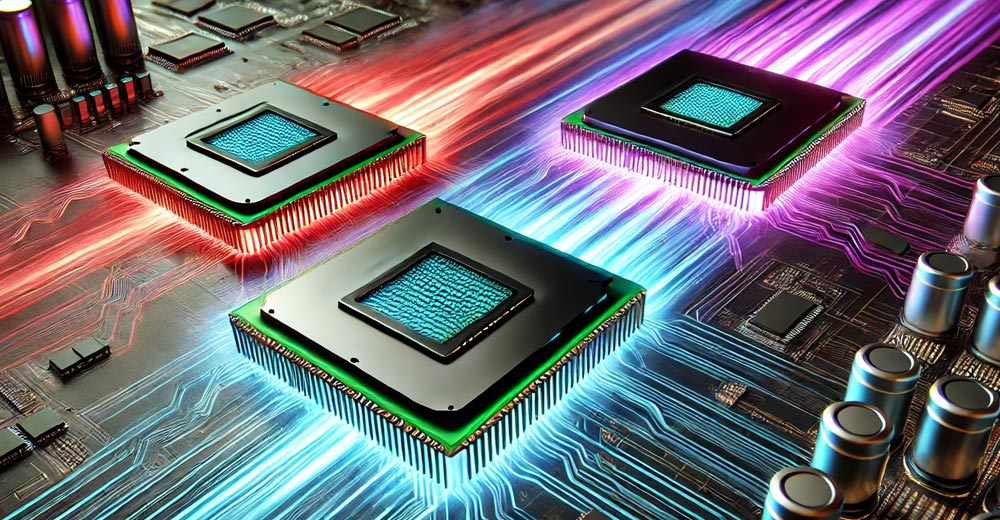The AI-Powered PC Wars: Qualcomm, Intel, and AMD’s Battle for Supremacy
Since Microsoft launched Copilot+, the past few months have been a battleground for PC manufacturers. Qualcomm initially had a huge lead, but then AMD and Intel came out with Copilot+ PCs that cut into that advantage.
AMD Outperforms Intel, Qualcomm Sees Decline
AMD outperformed Intel with a broader line of compliant products, while Intel focused on the premium market. Meanwhile, Qualcomm saw its design wins decline, and the laptop PC market has shifted more in AMD’s favor, though Intel remains the dominant player overall.
Why Didn’t Qualcomm Take the Lead?
Why didn’t we see the big shift to Qualcomm, and what happened to Intel that cost its CEO? Let’s break it down.
The Initial Struggle of Copilot+ PCs
Microsoft rushed to market with Copilot+ for PCs with two primary features: Cocreator, a derivative of Dall-E, which could have been pretty handy (I use Dall-E a lot these days). The other was Recall, an automatic indexing tool designed to help users find hard-to-locate files. That was pretty much it at launch.
Poor Positioning and Marketing
However, Microsoft positioned Recall poorly and had to pull it back. Cocreator by itself on a laptop — as opposed to a desktop PC or workstation where folks usually mess with graphics — turned out to be not very interesting. So, for a time, Qualcomm had only Copilot+ PCs. People weren’t too excited about Copilot+, and by the time Office began showcasing AI capabilities, PCs from AMD and Intel were available to run it.
Qualcomm’s Missteps
Unfortunately, Qualcomm’s brand name wasn’t as well known in PCs as AMD or Intel. In addition, Qualcomm’s product had a compatibility problem that made it largely unacceptable in large companies, so enterprise and large business sales never really emerged outside of trials.
The Need for Heavy Marketing
A heavy marketing campaign was needed to sell people on the features of running Copilot+ locally. That never emerged, so AI PCs became an AMD and Intel project, with Qualcomm increasingly on the sidelines.
What Qualcomm Should Have Done
Qualcomm had three advantages in the market: great battery life, the strongest wireless networking of any of the three vendors, and dominance in premium smartphones, which are basically pocket PCs. However, Qualcomm pushed hard on the AI aspect, which Microsoft fumbled badly. It did mention battery life, but it wasn’t successful in making its PCs 5G-capable, which removed that advantage. Finally, it didn’t have a “better together” story to leverage its strong smartphone advantage.
Qualcomm’s Opportunities and Missed Chances
Taking on entrenched vendors like AMD and Intel is very difficult, but Qualcomm almost acted like it wasn’t that important, even though it acted seriously about this market. In addition, because it had a compatibility problem, it needed to do targeted marketing for the low-hanging fruit: users who wouldn’t experience this shortcoming, influencers, small business owners, consultants, attorneys, and others who don’t run a lot of custom apps or need to play PC games on their laptops.
However, Qualcomm didn’t target these users. As a result, while compatibility improved, people tended to lose interest in Qualcomm’s offer over time.
Creating a Halo Product
Qualcomm could also have created a halo product that showcased its strengths. The HP Folio PC was an ideal configuration for much of the audience Qualcomm needed to capture, and it launched with an older Snapdragon processor and a 5G modem, making it nearly perfect.
Intel’s Challenges and Leadership Shake-Up
Intel and Microsoft don’t see eye to eye often, which has been problematic for both companies’ execution over the years. Intel seemed to take Microsoft’s requests as bad suggestions, which forced Microsoft to work with Qualcomm rather than Intel. AMD’s reputation was more on the high-performance side, and while AMD executed well, it didn’t have anything ready at launch. That gave Qualcomm the huge initial advantage that it failed to capitalize on.
The Consequences of Intel’s Strategies
This failure appeared to be connected to a prior CEO’s decision to reduce the focus on PC technology in favor of smartphones, an effort that failed spectacularly due to poor execution and some questionable behavior by Apple that left Intel out of step with both AMD and Qualcomm.
AMD’s Success
AMD’s people just put their heads down and executed, and of the three vendors, it ended up doing the best, even suggesting it would buy Intel. Qualcomm was on the list of companies looking to buy Intel, too. However, Intel is both more complex and far larger than either AMD or Qualcomm, making it unlikely that either company would be comfortable making this acquisition.
AMD’s Focus and Financial Results
AMD would be the strongest of the two because it shares both market coverage and x86 technology, meaning it would be better able to step in seamlessly to lead Intel. Still, given how complex Intel is and the cloud it’s under, it seems unlikely either firm will be able to make an Intel acquisition happen.
So, as AI hit, while Qualcomm had the initial potential benefit, AMD has seen the greatest benefit, primarily because it just outexecuted the other two companies.
The Importance of Focus
There is something to be said about focus. AMD showed an incredible level of focus over the last decade, which helped it achieve significant growth and benefit from the latest trends. Its recent financial results were impressive.
The Future of PCs and AI
It has been an interesting few months since Microsoft launched Copilot+. Execution was key, and AMD outperformed Qualcomm and Intel by just sticking to what it’s good at. However, Nvidia remains the king of AI in hardware, and it also has an Arm-based processor coming, which means it could disrupt the market as AI matures.
Nvidia’s Supremacy and Future in PCs
Thanks to Nvidia’s AI leadership, it’s already in a better position to steal market share than Qualcomm was. DeepSeek, which mainly uses older Nvidia technology, has shown a path forward that could favor Nvidia in future hardware if it decides to expand. Unlike Qualcomm, Nvidia is more likely to target both desktop and mobile PC markets. Notably, desktop PCs were overlooked in the Copilot+ rollout despite being the preferred platform for tools like Cocreator, which are commonly used for graphics development.
However, we are still at the very front of the AI wave. By the end of it, I expect both smartphones and PCs will have been replaced by hardware that better addresses the need to interact with AIs in a way we never did with PCs. A massive disruption is coming, and only Nvidia appears truly positioned to drive it. Well, and Huawei, but we’ll save that for another column.
The Tech Product of the Week: Yarbo AI-Powered Snowblower Robot
My Product of the Week is the Yarbo AI-Powered Robotic Snowblower. While I got my first Yarbo over a year ago, I never put it together because I’d broken my back and couldn’t mess with something that heavy. As it turned out, there were problems with that first generation, and Yarbo generously offered me the option of an upgrade to a newer unit for a relatively small upgrade cost compared to Yarbo’s $5,000 sales price.
The Yarbo is an AI-driven, GPS-connected yard robot. While I only have configurations for snow blowing and security (it can patrol the outside of your house), depending on the accessories you buy or use, it can also mow your lawn, spread fertilizer, pull a trailer (to stow it), and blow leaves. Mine is a blower only, but it also comes with a trailer hitch and a security head unit if I want it to patrol my yard after the snow melts.
The Yarbo is a game-changer for lawn care, and it has several features that make it stand out from other robotic lawn mowers. It uses a unique navigation system that allows it to map out your yard and avoid obstacles. It also has a robust snow-blowing mechanism that can handle heavy snowfall. Additionally, the Yarbo has a built-in Wi-Fi connection, which allows you to control it remotely using a smartphone app.
The Yarbo is also very easy to use, with a simple and intuitive interface that makes it easy to set up and use. It also comes with a comprehensive warranty, which gives you peace of mind knowing that you’re protected in case anything goes wrong.
Overall, the Yarbo is a fantastic product that has made my life easier and more convenient. It’s a great investment for anyone who wants to take their lawn care to the next level.
Source Link





